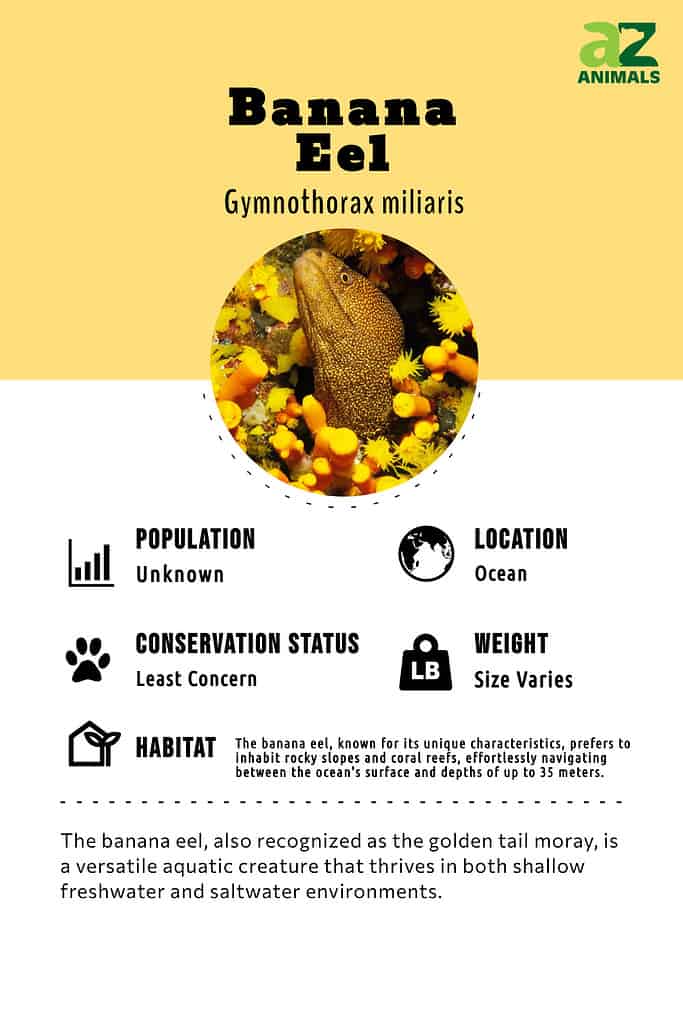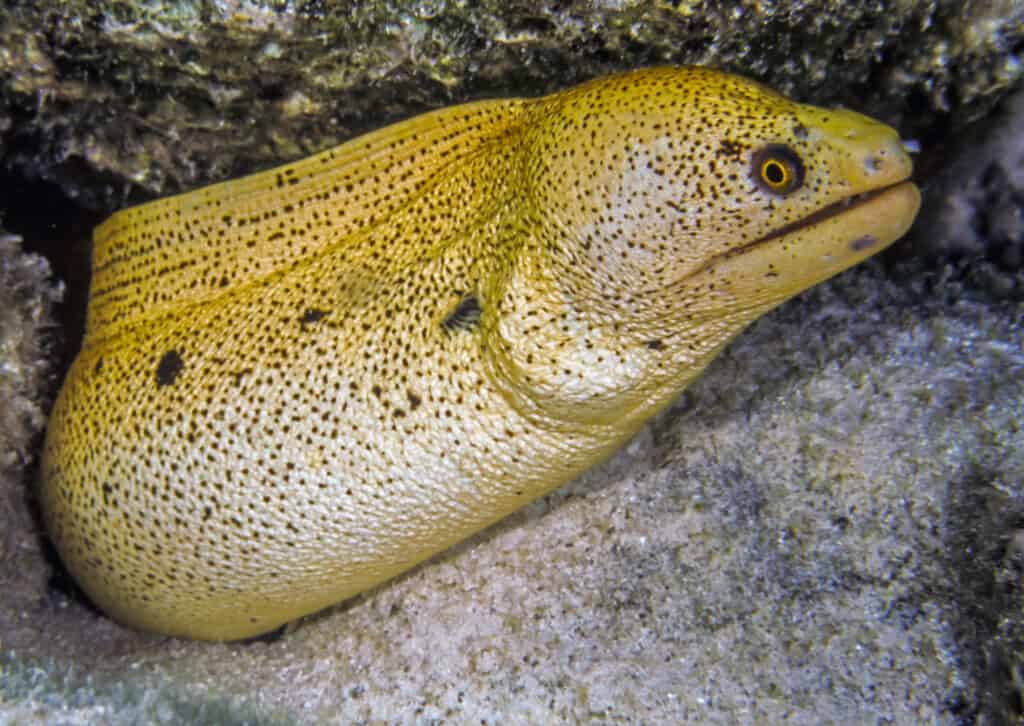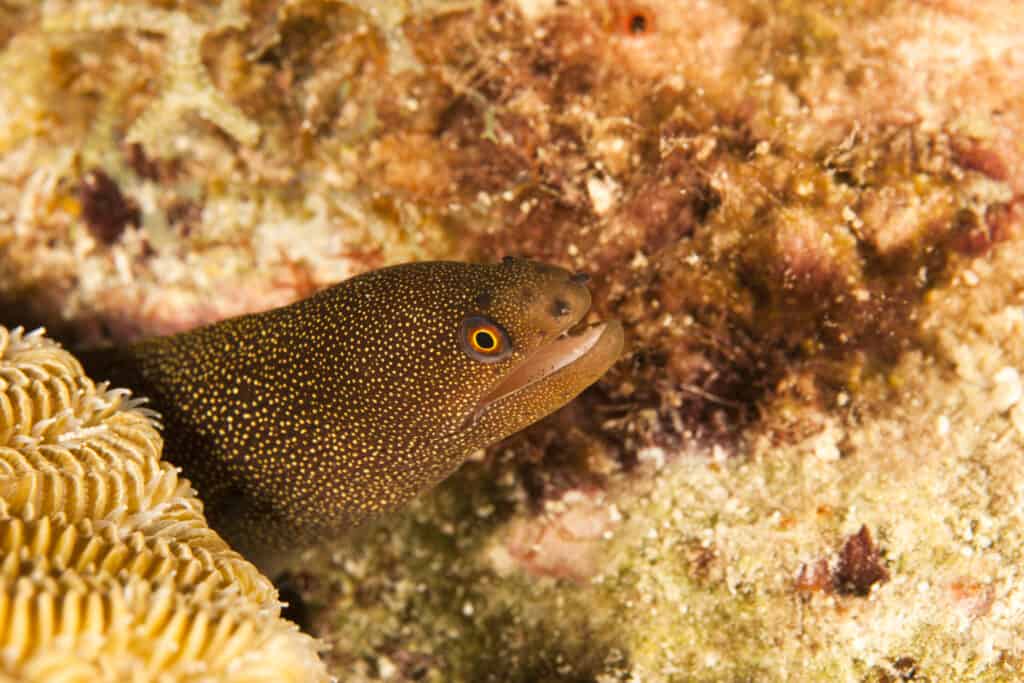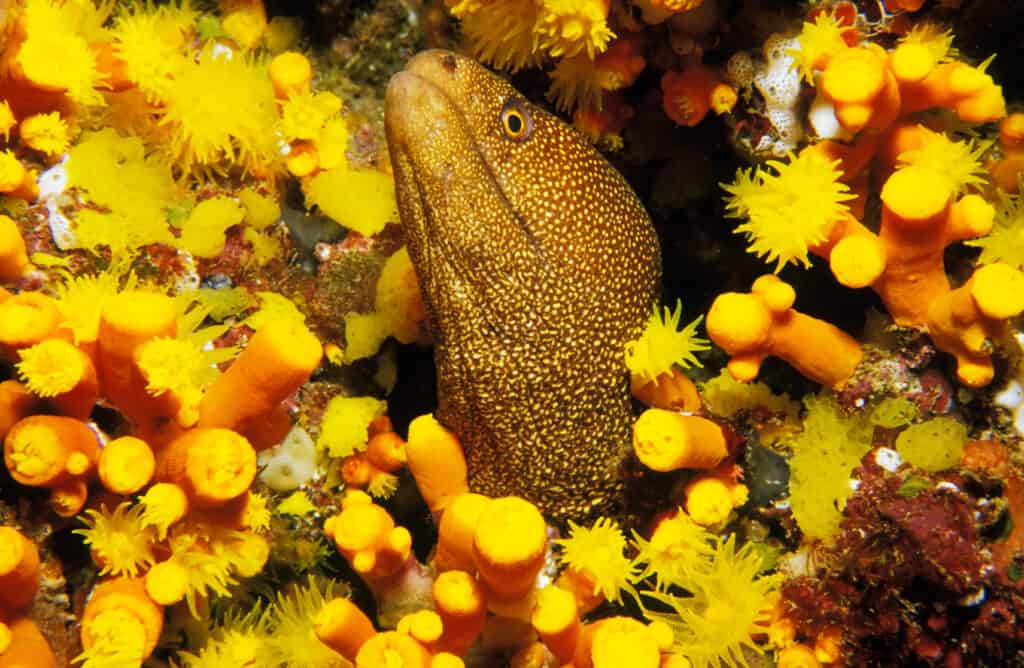Banana Eel
Gymnothorax miliaris
Named for the yellow body and brown spots that make it look like a banana.
Advertisement
Banana Eel Scientific Classification
- Kingdom
- Animalia
- Phylum
- Chordata
- Class
- Actinopterygii
- Order
- Anguilliformes
- Family
- Muraenidae
- Genus
- Gymnothorax
- Scientific Name
- Gymnothorax miliaris
Read our Complete Guide to Classification of Animals.
Banana Eel Conservation Status
Banana Eel Facts
- Prey
- Crustaceans, mollusks, small fish.
- Group Behavior
- Solitary
- Fun Fact
- Named for the yellow body and brown spots that make it look like a banana.
- Estimated Population Size
- Unknown
- Biggest Threat
- Bigger fish
- Most Distinctive Feature
- Yellow body
- Other Name(s)
- Golden banana moray eel, golden-tail moray, bastard eel, conger moray
- Optimum pH Level
- 8.1 – 8.4
- Habitat
- Reefs, rocky coasts, and other shallow waters with hiding places from predators.
- Diet
- Carnivore
- Type
- Fish
- Common Name
- Golden-tail moray
- Number Of Species
- 1
View all of the Banana Eel images!

The banana eel (also known as the golden tail moray) is a fish that thrives in shallow freshwater and saltwater.
It is primarily found in the Atlantic Ocean along the Gulf of Mexico and the Caribbean Sea. While it doesn’t have much commercial demand, the bright yellow appearance of this eel entices many exotic pet owners.
5 Incredible Banana Eel Facts!
- The banana eel can survive for up to 30 minutes outside of the water.
- To care properly for the banana eel, new pet owners should get a 125-gallon tank with plenty of space for hiding places, like corals or coves.
- They live for up to 15 years, and they are often adopted as pets.
- These eels primarily live near the equator in the Atlantic Ocean.
- To breathe, the banana eel has to keep its mouth open underwater.
Classification and Scientific Name

Gymnothorax miliaris is the binomial nomenclature for the banana eel.
©iStock.com/johnandersonphoto
The scientific name of the banana eel is Gymnothorax miliaris. The name “banana eel” is a moniker, as it is more commonly called the golden tail moray, bastard eel, or conger moray. This fish comes from the Anguilliformes order, which covers four main commercial species and 9 suborders. They are part of the Muraenidae family, which includes about 200 marine species of moray eels.
Evolution and Origins
The banana eel is a singular representative among the diverse group of approximately 200 moray eel species found globally. Its preferred dwelling is primarily within the vast expanse of the Atlantic Ocean, extending its reach across the Caribbean Sea and the Gulf of Mexico.
Notably, this species has been observed as far south as southeast Brazil and can be spotted in proximity to coastal regions such as Florida and Bermuda.
The Golden Banana Moray Eel originates from the coral reefs located along the South American coastline. In its natural habitat, it can grow up to a length of 2 feet. This species exhibits a captivating yellow hue, complementing its robust and muscular body structure, which is characteristic of most moray eels.
Appearance

The banana eel earns its name from its distinctive yellow body, which has become iconic.
©Brian Lasenby/Shutterstock.com
The iconic yellow body is the reason that the banana eel is called such. With a bright yellow hue and brown spots, their pattern looks like a perfectly ripened banana. The spots are much smaller on the head, gradually getting bigger along the body.
As a stark juxtaposition, the inside of the mouth is bright white.
Even though the banana eel is quite small, they still reach a modest 2-foot length when they are cared for in captivity. While it is possible to reach 70cm, it is far more likely that you’ll come across a 40cm banana eel instead. The average weight of the banana eel is not recorded.
Distribution, Population, and Habitat
Where to find: Banana Eels and How to Catch Them

Among the vast array of approximately 200 moray eel species worldwide, the banana eel stands as one distinctive member. Its habitat predominantly encompasses the Atlantic Ocean, encompassing the Caribbean Sea, and the Gulf of Mexico.
©Stubblefield Photography/Shutterstock.com
The banana eel is just one of about 200 different moray eel species in the world. It primarily lives in the Atlantic Ocean, spread throughout the Caribbean Sea and the Gulf of Mexico. It has even been spotted through southeast Brazil and as close to the coast as Florida and Bermuda.
The preferred habitat of this fish is along rocky slopes and coral reefs, moving effortlessly between the surface and 35 meters below it. Some reports show that they’ve been able to reach depths of nearly twice this much.
If you adopt one of these fish, the optimal tank size is 125 gallons, ranging from 73 to 78 degrees Fahrenheit with 1.020-1.025. The preferred climate of the banana eel is saltwater. Currently, the conservation status of banana eels is Not Extinct.
Predators and Prey
The primary diet of the banana eel is carnivorous, seeking out smaller fish, invertebrates, and crustaceans. While it is easy for the banana eel to track down this food on its own in its natural habitat, providing it with enough nourishment while in captivity could be difficult, due to lack of access.
To hunt, this moray goes out at night, seeking out food along the reef. However, this habit isn’t set in stone, because they’ll look for food in the daytime if they need to.
What Eats Banana Eels?
While the banana eel already hunts fish that are smaller than itself, it is part of the diet of many larger fishes. No specific animal dines on banana eels exclusively, but any carnivorous fish that is bigger than the banana eel will go after this fish for dinner.
What Does a Banana Eel Eat?
The banana eel eats small invertebrates that can be found on the coral reef, including mollusks and crustaceans. Though it may eat small fish as well, they are not ordinarily the eel’s preferred meal.
Reproduction and Lifespan

As pets, banana eels require a 125-gallon tank and plenty of hiding places.
©iStock.com/Miguel Angelo Silva
The oviparous female banana eel needs to mate with multiple males to release her eggs. The eggs are released over long distances, rather than in large groups like other fish might lay them. They are quite durable, even surviving at shallow depths as they grow. However, very little is known about their mating habits or even when they reach sexual maturity.
Breeding is not often encouraged within captivity because it is hard to tell a male from a female. Furthermore, the larvae (also known as elver) must be able to drift along in the sea for months before they ever develop into young eels, which is not something that can be replicated in captivity.
The average lifespan of the banana eel is 12-15 years.
Fishing And Cooking
For the most part, all moray eels are avoided in cooking. The majority of species have toxic skin that is dangerous to humans, and it is not commercially fished in high enough quantities to be considered a common food.
View all 284 animals that start with BBanana Eel FAQs (Frequently Asked Questions)
Can you have a banana eel as a pet?
Yes. However, there is a lot of care that goes into keeping up with the banana eel properly. For the most part, they are fairly hardy, If you choose to adopt more than one, take care to select the right tank mates as they can be temperamental. Their tank size should be large, providing plenty of space for corals, caves, and other places to hide.
The average price to adopt a banana eel is at least $1,000, though you will need to factor in the price of the right tank size and any tank mates you adopt as well initially. Their price ultimately is decided by the size and age of the fish. Don’t adopt smaller fish as tank mates as the banana eel will primarily see them as food. Proper veterinary care should be established soon after adoption.
What do banana eels eat?
The preferred diet of the banana eel is crustaceans. However, when the opportunity arises, they will occasionally eat smaller fish, especially if they are kept as tank mates in captivity.
Where do banana eels live?
Though many banana eels are sold in the pet trade, their native habitat is in the Atlantic Ocean in depths of up to 35 meters on average. However, they may go twice this deep in search of food or shelter.
How much is a pet banana eel?
The average price of adoption starts at $1,000, but the age and size will adjust this total cost.
Thank you for reading! Have some feedback for us? Contact the AZ Animals editorial team.
Sources
- Aquariadise / Accessed March 1, 2022
- Fantasea Aquariums / Accessed March 1, 2022
- Wikipedia / Accessed March 1, 2022
- Mexico - Fish, Birds, Crabs, Marine Life, Shells and Terrestrial Life / Accessed March 1, 2022
- Aquarium Codex / Accessed March 1, 2022
- The Mandarin Garden / Accessed March 1, 2022


















